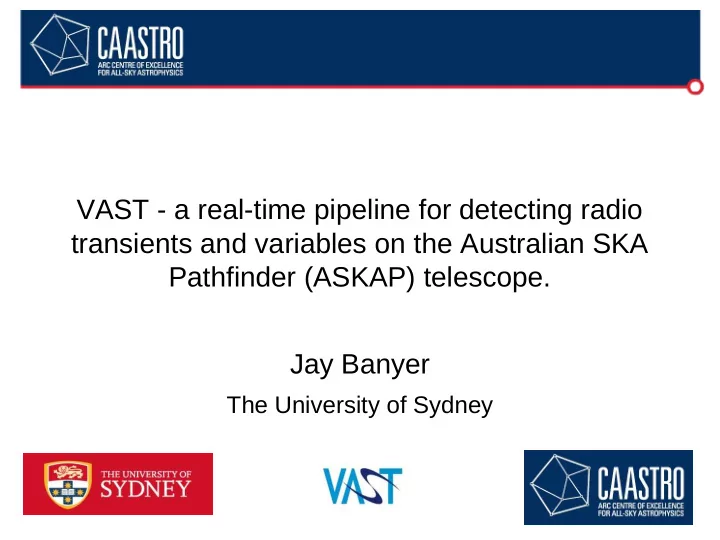

VAST - a real-time pipeline for detecting radio transients and variables on the Australian SKA Pathfinder (ASKAP) telescope. Jay Banyer The University of Sydney
Presentation Overview › The Australian Square Kilometre Array Pathfinder (ASKAP) radio telescope › The Variable and Slow Transient (VAST) project: - Survey and project overview - Pipeline overview - Capacity challenges - Prototype pipeline ADASS 2011 - Jay Banyer 2
ASKAP: Australian SKA Pathfinder › 36 dish radio interferometer › Very fast survey speed: can image the entire visible sky in two nights – current telescopes take years! › Located in the desert in Western Australia › Radio quiet site › First science in 2013 Credit: John Sarkissian, CSIRO Credit: Ant Schinckel, CSIRO ADASS 2011 - Jay Banyer 3
VAST Survey Overview › Goals: - Detect variable and transient phenomena at radio wavelengths - Achieve an unprecedented combination of sky area, sensitivity and time sampling - Automatic classification of sources - Automatic triggering of events to the community e.g. VOEvent › All in near real-time › Several survey regimes, including looking at most of the southern sky every night for 2 years › “Slow” transients means changes over 5 seconds or more ADASS 2011 - Jay Banyer 4
Spot the difference? SN 1987A, Molonglo Observatory Synthesis Telescope (MOST) ADASS 2011 - Jay Banyer 5
VAST Pipeline Functionality Images Source Finding Source Association Image: Jon Morse/NASA Image: usvao.org Source Monitoring Light Curve Transient Detection VOEvent Creation & Classification ADASS 2011 - Jay Banyer 6
VAST Collaboration › A collaboration with diverse scientific interests. › Led by Tara Murphy (The University of Sydney) and Shami Chatterjee (Cornell University) › http://www.physics.usyd.edu.au/sifa/vast and others... ADASS 2011 - Jay Banyer 7
Source Finding in VAST Image ref: Paul Hancock ADASS 2011 - Jay Banyer 8
VAST Capacity Challenges › Input rate: - 1 x ~8GB image cube every 5s (60TB / day) - 1 x larger, more sensitive image cube e.g. every 1 hour › ~20,000 Gaussian fits per second › ~20,000 measurements stored per second › ~5,000 cone search queries per second › ~5,000 light curve changes per second to analyse › ~720 million measurements stored per 10 hour observation › We need a big computer! ADASS 2011 - Jay Banyer 9
A big computer? Credit: http://www.ronmartin.net ADASS 2011 - Jay Banyer 10
ASKAP Computer › A petascale computing cluster at the Pawsey Supercomputing Centre in Perth, Western Australia › Will be one of the most powerful supercomputers globally › This cluster will run the telescope imaging etc. and the science pipelines including VAST Credit: iVEC ADASS 2011 - Jay Banyer 11
VAST Pipeline Prototype › The VAST collaboration is developing a prototype pipeline › Goals: - Develop the functional requirements for the real pipeline - Discover and address the issues facing the VAST survey - Do transient detection on data from other telescopes: - ASKAP BETA (ASKAP with 6 or 12 dishes) - Murchison Widefield Array (MWA) - Australia Telescope Compact Array (ATCA) - Very Large Array (VLA) (archival) - SKA Molonglo Prototype (SKAMP) ADASS 2011 - Jay Banyer 12
VAST Pipeline Prototype › Pipeline is fully automatic › Dynamic website to view results › Handles FITS images from any radio telescope (with minor adjustments, in theory...) › Implemented in Python › PostgreSQL database with Q3C for coordinate searches › Django for dynamic website › Libraries: aplpy, pyfits, pywcs, matplotlib, mpfit › Capacity: ~20 source measurements per second. 1000 times too slow... but it's a prototype! ADASS 2011 - Jay Banyer 13
VAST Prototype Screenshots ADASS 2011 - Jay Banyer 14
Summary › ASKAP is a radio telescope with unprecedented survey speed being built in Western Australia › The VAST survey will detect radio transients and variables using ASKAP › VAST will use a near real-time pipeline on a large computing cluster and will face significant capacity challenges › A prototype pipeline exists and is under continuing development. It can be used on data from any radio telescope ADASS 2011 - Jay Banyer 15
Recommend
More recommend